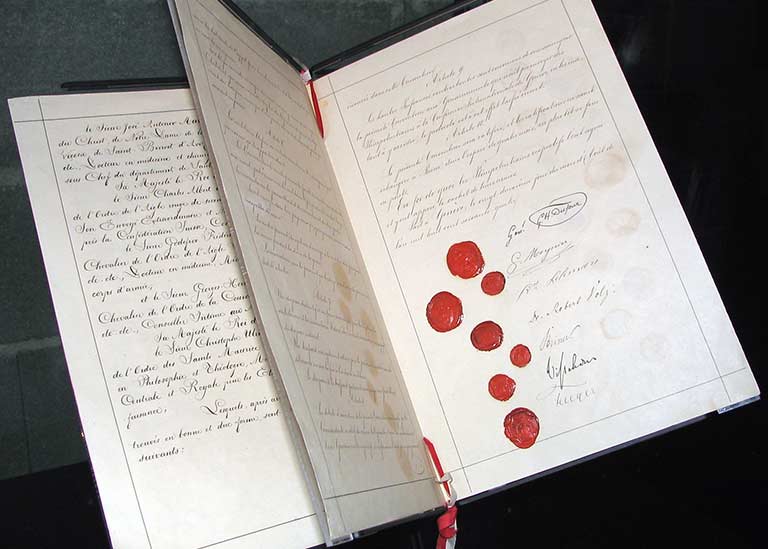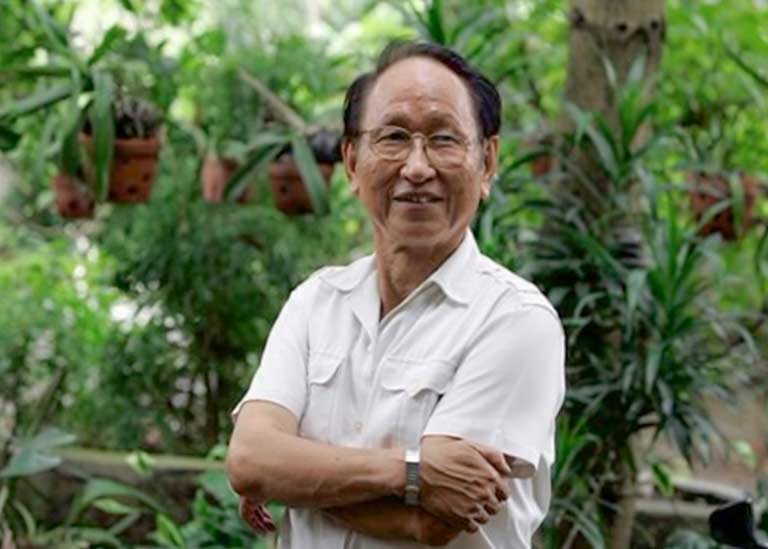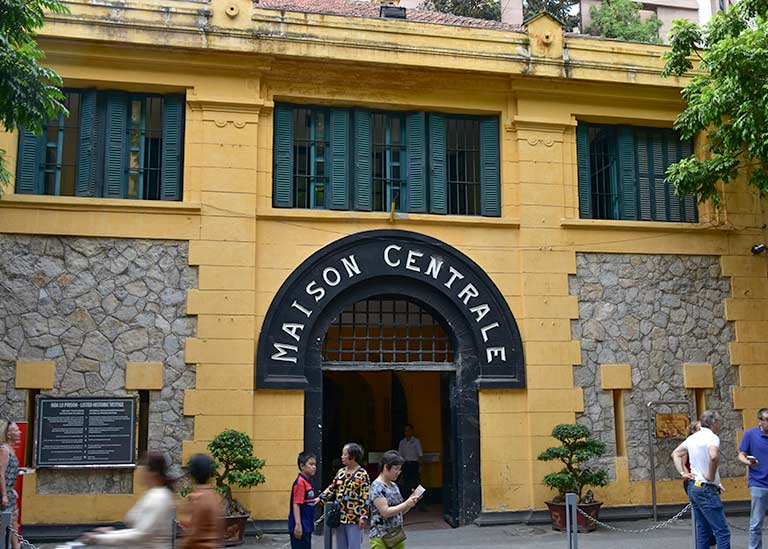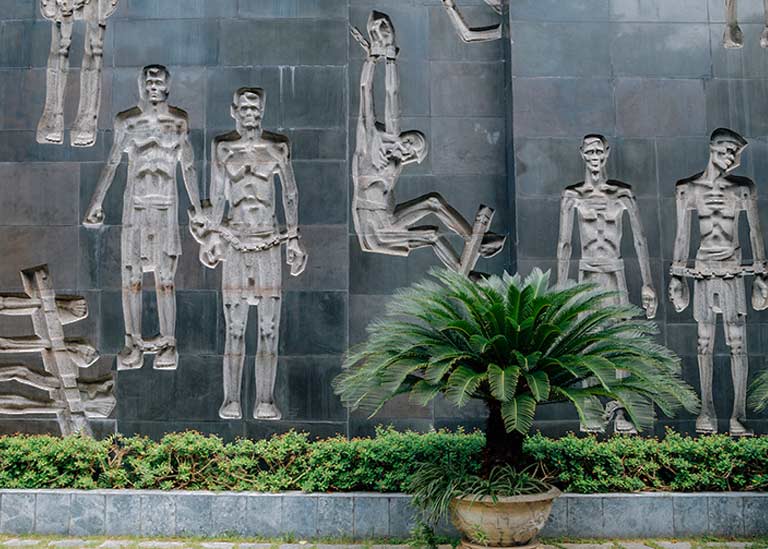Back to Homepage / Blogs / May 2023
Hanoi Hilton
The Hanoi Hilton was a prison in Hanoi, Vietnam that was used during the Vietnam War to house American
prisoners of war, mainly downed pilots and aircrew. It was known for its harsh conditions and torture. The Hanoi Hilton is one of the most famous symbols of the
Vietnam War. The Vietnamese called the prison Hoa Lo, which translates to "fiery furnace" and even "Hell's hole". It was sarcastically dubbed the Hanoi Hilton by
the American POWs in reference to the famous Hilton group of hotels. The prison was opened in 1959 and was closed in 1975. It was demolished during the 1990s and
what remains now is a museum.
History of the Hanoi Hilton
Vietnam was part of a French colony called French Indochina from the late 1800s to 1954. The prison Hanoi Hotel was built by the French between 1886 to 1901.
The French called it Maison Centrale or Central House. The prison was built to house Vietnamese prisoners, especially political prisoners who were fighting for
independence. These prisoners were subjected to extreme torture and were even executed on the prison premises.
The prison originally held up to 460 inmates, but it was renovated in 1913 to increase its capacity to 600. However, the prison held thousands of prisoners in
overcrowded cells, and often in subhuman conditions. When the French were ousted in 1954, the prison had over 2000 inmates living in squalid conditions.
After the French left, the prison came under the authority of the Vietnamese Govt. The prison was used as an education center until America sent its combat
forces into Vietnam during the infamous Vietnam War. It was then used as a prison to hold American prisoners of war.

Exterior of prison

Lieutenant Junior Grade Everett Alvarez Jr
The Vietnam War
The Vietnam War started on 1st November 1955 and lasted until 30th April 1975. The first American prisoner to be sent to the Hanoi Hilton was Lieutenant Junior
Grade Everett Alvarez Jr. He was shot down on 5th August 1964 and spent nearly eight years in captivity.
The Vietnam War lasted nearly two decades and over 700 American soldiers were held captive by the Vietnamese forces. For those locked inside the Hoa Lo prison,
it meant years of torture and abuse. Besides long periods of solitary confinement, prisoners were often strapped down with iron stocks that were left over from
the French era. These stocks were small and often cut into the prisoners' wrists and ankles, turning their skin black. Due to the unsanitary conditions of the
prison, pests like cockroaches and rats were quite common. These often scurried over the prisoners' bodies and bit them. The prisoners were also brutally beaten
and made to stand on stools for days on end.
The irony was that Vietnam was the third signatory of the Third Geneva Convention of 1949. The Geneva Convention demands the decent and humane treatment of
prisoners of war. Despite that, Vietnam employed severe torture methods, including rope bindings, beatings, and extended solitary confinement.
In an interview, former Senator John McCain spoke about his time at the Hanoi Hilton. He was a naval aviator captured by the Vietnamese in 1967 and spent more
than 5 years in the Hao Lo prison. He said, "I thought perhaps I was going to die."

The Geneva Convention

Senator John McCain
The torture of American POWs
Nearly 114 American prisoners of war died in captivity at the Hanoi Hilton. Many of the released prisoners went on to become prominent public figures. Some of
them spoke out about the horrors they suffered during captivity.
Former Senator Jeremiah Denton said that they were beaten with fan belts and fists. He even talked about the "rope trick" used by the Vietnamese. US
Representative Sam Johnson went on to describe the rope trick. He said that there would be a meat hook fixed to the ceiling. During routine torture, the
Vietnamese would tie a soldier's hands and feet and then tie his hands to his ankles. Sometimes the hands were tied behind the back and sometimes in front.
The ropes were then tightened to the point that breathing became difficult. The bet soldier was then hoisted and hung from the meat hook with ropes. The
Vietnamese would come at intervals and keep tightening the ropes until there were no sensations left in the limbs. This would often go on for hours and in extreme
cases for days. As a result, the prisoner's limbs turned purple and swelled to almost double the normal size.
John McCain was already injured when he was captured in 1967. His right arm and knee were broken in the plane crash, but the Vietnamese still denied him medical
attention. It was only when they discovered that McCain's father was a US Navy Admiral did they transfer him to a medical facility. The Vietnamese even offered
McCain an early release, hoping to use him as a propaganda tool. But, McCain refused in solidarity with his fellow prisoners, which earned him even more
torture.

Torture Methods

Torture
Methods
American resistance at the Hanoi Hilton
The American soldiers endured years of torture but they stayed strong. They even devised methods to communicate with each other. Lt. Cmdr. Bob Shumaker saw an
American inmate regularly dump his slop bucket outside. He scratched out a note on a piece of toilet paper that said "Welcome to Hanoi Hotel. If you get the note,
scratch your balls as you're coming back." He then stuck the note in a crack in the wall. A few minutes later, the other American soldier walked through the
courtyard scratching his crotch. He also managed to leave a reply that said, "Ron Storz, Captain USAF."
With more prisoners coming in, the Americans realized that they had to find a way to communicate with each other. They couldn't use Morse Code because even the
Vietnamese understood that. Then he remembered a tap code that he learned in the Air Force Survival, Evasion, Resistance, and Escape School. The tap code was
originally developed by American POWs in Korea.
That's how the Americans communicated with each other, warning others about guards and checking in on one another. They would even go over what to explain in
interrogations and encourage each other to not give up. They even used the tap code method to crack jokes.
The best example of the American resistance at the Hanoi Hilton was displayed by Jeremiah Denton. He famously blinked the word "torture" in Morse code when
taken before cameras to film antiwar propaganda for the Vietnamese. Denton's captors believed they had broken him and so allowed a Japanese TV reporter to
interview him on 2nd May 1966. The blinding floodlights made him blink, which gave him the idea. He looked directly into the cameras and blinked the word torture,
which told the world the truth behind the walls of the Hanoi Hilton. Of course, Denton was tortured afterward. His brave act earned Denton the Navy Cross after
his release.
The US and North Vietnam agreed to a ceasefire in 1973. At that time, there were 591 POWs still in captivity who were then released.

Jeremiah Denton

Jailer Tran Trong Duyet
What happened after the war?
The Vietnam war ended after the Paris Peace Accords were implemented in 1973. However, America or its allies never formally charged Vietnam for war crimes. In
the 2000s Vietnam held the position that the claims of torture at Hao Lo and other prisons were fabricated. It now wants to put the past behind it and develop
cordial relations with the US. Jailer Tran Trong Duyet, who commanded the Hao Lo prison for the last three years of the war also maintained that there was no
torture. However, American POWs had a different story to tell.
US pilot James Robinson Risner wrote the book "Passing of the Night" detailing the seven years he spent at the Hanoi Hilton. There have also been other
literature that depicts the torture American soldiers went through in the prison.
Hanoi Hilton: Present day
The Hanoi Hilton has now been converted into a museum. Of course, the story is told from the Vietnamese standpoint, so you will not find mentions of
torture.
Upon entering the gate, you will be guided to a long building. The first room you enter showcases the Phu Kanh village that once stood on the site of the Hao
Lo prison. The villagers mainly traded in ceramic vessels, which gave the street its name-Hao Lo, which means stove or fiery furnace.
In the second room, you see a diorama of the Hao Lo prison and a large iron gate. The E stockade room contains life-size models of Vietnamese prisoners during
the French era shackled in two rows. On the side, there is a dungeon where dangerous prisoners were kept in solitary confinement.
After you exit the solitary area, there is a long corridor with several memoirs of Vietnamese prisoners. It also includes a sewer through which five Vietnamese
inmates escaped in 1951. At the end of the corridor, you will find the quarters of female prisoners. Apparently, the female prisoners were spared from the harsh
torture during the French era. Immediately after the female quarters, you will find the death-row dungeon. The guillotine standing against the wall bears
testimony to the torture that took place in this room.
The largest area in the Hao Lo museum is the Memorial Garden which was built to honor the dead in the Vietnam revolution. You can see a few glimpses of the
American POW experience at the Hanoi Hilton in the blue room. Of course, it is a highly sanitized view. The gallery also displays the American pilot exhibit,
which displays the pilot suit worn by McCain when he was captured. The gallery tells stories about the harm brought about in Vietnam by American planes. This
seems like a justification for the imprisonment of American soldiers during the Vietnam war.
Most of the museum is about the building's time as a French prison. There is absolutely nothing that depicts the gruesome horrors that American POWs underwent
in that prison.

Hanoi Hilton Present Day

Hao Lo Museum Memorial Garden
We visit the Hanoi Hilton in the morning when we arrive at Hanoi on our Halong Bay & Red River cruise and our Halong Bay, Red River & Laos combo cruise.
Similar blogs you may find of interest are 'Happy Ending - how a veteran Vietnam war protestor found peace with Pandaw' and 'Greeneland meets Vietnam - The Quiet American'.